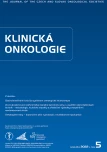Biphenotypic sinonasal sarcoma – a case report
Authors:
V. Bartoš 1; P. Rác 2; A. Skálová 3
Authors place of work:
Martinské bio ptické centrum, s. r. o., Martin, Slovenská republika
1; Otorinolaryngologické oddelenie, Nemocnica s poliklinikou, Považská Bystrica, Slovenská republika
2; Šiklův patologický ústav, Univerzita Karlova, Lékařská fakulta v Plzni a Bioptická laboratoř s. r. o., Plzeň
3
Published in the journal:
Klin Onkol 2022; 35(5): 402-406
Category:
Kazuistika
doi:
https://doi.org/10.48095/ccko2022402
Summary
Background: Biphenotypic sinonasal sarcoma (BFSS) is a topographically specific low-grade sarcoma that was first described only 10 years ago. The term biphenotypic comes from the co-expression of markers of muscle differentiation and neural crest that is characteristic for this tumor. Case: A 78-year-old woman manifested with prolonged breathing difficulties through the left nasal passage. Rhinoendoscopy and CT scans showed an obturation of the middle and posterior part of the left nasal cavity by a polypoid tumor mass with a stalk in the ethmoid sinus. It spread into the nasopharynx. The tumor was resected and extracted from the nasopharynx through the oral cavity. Grossly, it was a compact polyp measuring 6 × 3,5 × 3 cm. Histology revealed a uniform neoplastic spindle cell population arranged in a fascicular pattern. It expressed S100 protein, smooth muscle actin, calponin and muscle-specific actin. Molecular genetic analysis of the tissue showed PAX3:: MAML3 gene fusion. The findings confirmed a diagnosis of BFSS. Conclusion: BFSS is a very rare, locally aggressive malignant tumor without metastatic potential. In contrast to other malignancies in a given locality, it possesses a relatively favorable prognosis. In biopsy practice, the pathologist‘s knowledge of this unique histopathological entity is principal because it should be always considered when encountering a low-grade spindle cell neoplasia arising in the sinonasal region.
Keywords:
biphenotypic sinonasal sarcoma – S100 protein – smooth muscle actin – PAX3::MAML3
Zdroje
1. Kawaguchi M, Kato H, Tomita H et al. Imaging characteristics of malignant sinonasal tumors. J Clin Med 2017; 6 (12): 116. doi: 10.3390/jcm6120116.
2. Andreasen S, Bishop JA, Hellquist H et al. Biphenotypic sinonasal sarcoma: demographics, clinicopathological characteristics, molecular features, and prognosis of a recently described entity. Virchows Arch 2018; 473 (5): 615–626. doi: 10.1007/s00428-018-2426-x.
3. El-Naggar AK, Chan JKC, Grandis JR et al. WHO classification of head and neck tumours (4th edition). IARC: Lyon 2017.
4. Lewis JT, Oliveira AM, Nascimento AG et al. Low-grade sinonasal sarcoma with neural and myogenic features: a clinicopathologic analysis of 28 cases. Am J Surg Pathol 2012; 36 (4): 517–525. doi: 10.1097/PAS.0b013e31824 26886.
5. Carter CS, East EG, McHugh JB. Biphenotypic sinonasal sarcoma: a review and update. Arch Pathol Lab Med 2018; 142 (10): 1196–1201. doi: 10.5858/arpa.2018-0207-RA.
6. Gross J, Fritchie K. Soft tissue special issue: biphenotypic sinonasal sarcoma: a review with emphasis on differential diagnosis. Head Neck Pathol 2020; 14 (1): 33–42. doi: 10.1007/s12105-019-01092-4.
7. Chitguppi C, Koszewski I, Collura K et al. Biphenotypic sinonasal sarcoma – case report and review of clinicopathological features and diagnostic modalities. J Neurol Surg B Skull Base 2019; 80 (1): 51–58. doi: 10.1055/s-0038-1667146.
8. Kalita O, Ćwiertka K, Vrána D et al. Multimodal therapy of recurrent malignant schwannoma. Klin Onkol 2016; 29 (5): 364–368. doi: 10.14735/amko2016364.
9. Veselý K, Krpenský A, Jedlička V. Solitární fibrózní tumor plic. Klin Onkol 2003; 16 (6): 272–275.
10. Bílek O, Tuček Š, Veselý K et al. Malignant melanoma treated with radical chemotherapy, resemblance histology of melanoma to soft tissue sarcomas, case report. Klin Onkol 2013; 26 (1): 42–46. doi: 10.14735/amko201342.
Štítky
Dětská onkologie Chirurgie všeobecná OnkologieČlánek vyšel v časopise
Klinická onkologie

2022 Číslo 5
- Metamizol jako analgetikum první volby: kdy, pro koho, jak a proč?
- Specifika v komunikaci s pacienty s ránou – laická doporučení
- Léčba akutní pooperační bolesti z pohledu ortopeda
- Nejasný stín na plicích – kazuistika
- Výzkum na téma hojení ran: Pouze třetina populace ví, co je chronická rána, jen desetina tuší, že její léčba je hrazená
Nejčtenější v tomto čísle
- Gastrointestinální toxicita systémové onkologické imunoterapie
- Onkologické rány – doporučení péče vycházející z multioborové spolupráce
- Přínos empatie lékaře pro jeho pacienty a výsledky začlenění rozvíjení schopnosti empatie do kurikul lékařských fakult
- Bifenotypový sinonazálny sarkóm – opis prípadu
